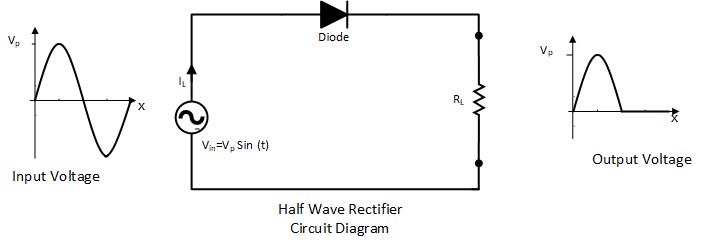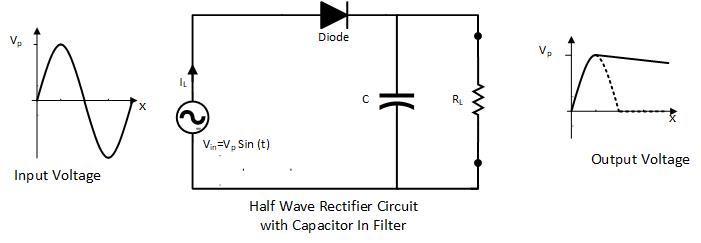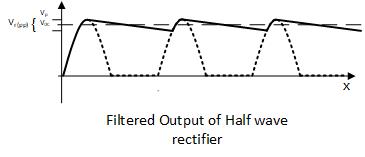The ability of the diode to conduct current in one direction and block it in another direction and can be used as a rectifier. Rectifiers are the electrical circuit that converts the AC voltage to DC voltage. All electronic appliances work on DC voltage rather than AC, so rectifiers are an essential part of all electronic appliances. The simplest rectifier is a half-wave rectifier with a capacitor filter.
The following diagram shows the half-wave rectifier circuit where the diode, load, and sinusoidal AC source are connected.

- Elevate Your Boating Experience with a Marine SoundBar
- Efficient Travel Refrigerator for Cars: A Complete Guide
Half-wave Rectifier’s Working
A positive cycle of a half-wave rectifier
For the positive half cycle of the input sinusoidal voltage, the anode of the diode is connected with the positive side of the source, the cathode is connected with the negative side of the source and the diode becomes forward biased. So, for the positive half cycle, the output is the same as the input ideally. The current will pass through the load resistor during the positive half cycle. For practical purposes, the output voltage will be less than 0.7 volts. Before the diode becomes forward bias the input must overcome the barrier potential of the PN junction, that’s why the output in the practical diode will be less by 0.7 volts.
The negative cycle of a half-wave rectifier
For the negative half cycle, the anode of the diode will connect with the negative side of the source and the cathode will connect with the positive side of the source, and the diode becomes reverse biased. Ideally, the diode will act as an open switch and no current will pass through the load resistor. But practically there will be a small leakage current. Another thing is that the diode can withstand up to breakdown voltage. So the reverse blocking voltage must be in the range of the withstanding voltage. For safer operation, the maximum input voltage must be 20% less than that of the PIV (Peak Inverse Voltage) rating of the diode.
The output of a half-wave rectifier
The output of the half-wave rectifier does not change the direction of current in the load resistor, that’s why it is called DC voltage. But the magnitude of the voltage varies with time so it is called pulsating DC voltage. A steady-state DC can be achieved by using a filter circuit.
The Average Output of a Half-wave Rectifier
The average value of the input sinusoidal voltage is zero because of the same area above and below the axis line. Where the average value of the output can be calculated as follows
$v_{avg}=\frac{V_{p}}{2\pi }(\int_{0}^{\pi }{sin t dt}+\int_{\pi }^{2\pi }{0 dt} )$
$v_{avg}=\frac{V_{p}}{2\pi }(2+0)$
$v_{avg}=\frac{V_{p}}{\pi }$
$v_{avg}=0.318 V_{p}$

The DC voltmeter will measure the average value of the half-wave rectifier.
The Output of Half Wave Rectifier with a Capacitor Filter
The output of the Half Wave rectifier is pulsating DC instead of steady-state. Where the electronic devices work on steady-state DC and some devices may respond unexpectedly to such type of pulsating DC. A filter circuit may be required to convert the pulsating DC to steady-state DC, whereas a simple filter circuit can be a capacitor input filter. In the capacitor input filter circuit, the output of the half-wave rectifier is passed through a capacitor as the following circuit shows.

For the first quarter of the positive cycle of the input voltage, the capacitor will charge up to the supply maximum voltage Vp. For the second quarter of the positive cycle, the diode will become reverse-biased because the cathode is at a higher potential than the anode. So, for the rest of the cycle, the capacitor will provide current to the load and discharge until the supply voltage becomes more than that of the capacitor voltage. As the input voltage increases from the capacitor voltage the capacitor will again start charging and the chain will remain. The discharging time of the capacitor depends upon the RC time constant.

DC Voltage of the Half Wave Rectifier
In the filtering action, the capacitor charges quickly and discharges slowly because of load resistance. That causes a change in voltage across the capacitor, which is undesirable and called ripple voltage.
$v_{r(pp)}\approx (\frac{1}{fR_{L}C})v_{p}$
$v_{DC}\approx (1- \frac{1}{2fR_{L}C})v_{p}$
Ripple Factor of a Half-Wave Rectifier
A measure of the effectiveness of the filter can be judged by the parameter called ripple factor. The formula of the ripple factor is the ratio between ripple voltage (peak to peak) and DC voltage.
$r=\frac{v_{r(pp)}}{v_{DC}}$
Half Wave Rectifier Application
Half-wave rectifiers are NOT commonly used for rectification purposes as their efficiency is too small. A half-wave rectifier may still be used for rectification, signal demodulation application, and signal peak detection application.
Advantages of a Half-wave Rectifier
Half-wave rectifier’s benefit is its simplicity as it requires fewer components so it is comparatively cheap upfront.
Disadvantages of a Half-wave Rectifier
- Top 5 Essential Electrical Wiring Rules to Follow for Your Home
- Breaker Size Calculator: AC and DC Circuit Breaker Sizing Calculator
The half-wave rectifier loses the negative half-wave of the input sinusoidal which leads to power loss. Its output is not pure DC as it contains ripples. It produces comparatively low output voltage.
Conclusion:
- A rectifier converts AC voltage to DC voltage.
- Half wave Rectifier with a capacitor filter only passes current through load during the positive half cycle of sinusoidal.
- The output of the half-wave rectifier is pulsating DC voltage, to convert it to a steady state, a filter is used.
- The effectiveness of the filter can be measured by the ripple factor.
vDC≈1−(1/(2fRLC))vp
should be
vDC≈Vp−(1/(2fRLC))vp or
vDC≈(1-1/(2fRLC))vp
otherwise, the result is always 1 minus half of the ripple Voltage.
Thanks for your suggestions, it corrected after confirmation.
This is good,
inquiring if ripple factor can be determined in any experiment
Yes, you can measure the Vrpp and VDC in any digital oscilloscope and utilizing the formula above, you can easily calculate the Ripple Factor your filter.
Yes, you can measure the vrpp with an oscilloscope and Vdc.